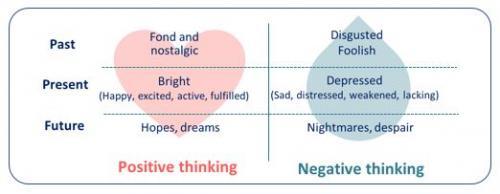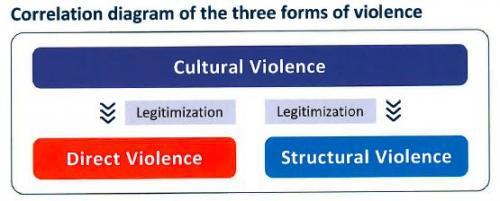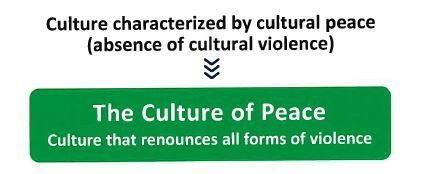3) What is the Culture of Peace?
In relation to human feelings and behaviors, the City of Hiroshima defines peace and the culture of peace as follows:

- In life, people are prone to positive and negative feelings. Therefore, peace can be referred to as maintaining a day-to-day living environment where positive thinking comes more easily.
- The culture of peace can be referred to as the various actions that are indispensable to create such an environment and all of their results.
- An example of the culture of peace is music, fine art, and other cultural arts, as well as sports. As the arts and sports both transcend the boundaries of language, nationality, beliefs, and gender, they can be considered part of the culture of peace when undertaken in support of peace.
Dr. Johan Galtung, a Norwegian sociologist who is renowned as the father of peace studies, states that if the opposite of violence is peace, then the culture of peace can be explained as follows:
There are three forms of violence: direct violence, structural violence, and cultural violence. According to Dr. Galtung, direct violence is exercised in situations such as wars and military conflicts. Structural violence can be found in life-threatening situations caused by factors like racial and social discrimination. Cultural violence can be referred to as aspects that are used to legitimize direct violence and structural violence.
Dr. Galtung describes that a situation where cultural violence is not found would be cultural peace, and a culture where many aspects of cultural peace are found can be referred to as a peace culture.

Under this concept, we define the culture of peace as culture that affirms the absence of cultural violence and renounces all forms of violence.

For these reasons, we can define the promotion of the culture of peace as cities working to create the following environments so that we can build a world where no one is excluded and differences between individuals and groups are respected:
- An environment where each and every citizen acknowledges that what is important for living happily is being free from war, military conflicts, and life-threatening social discrimination.
- An environment where, based on their own thoughts, citizens do what they can for peace in their day-to-day lives.
Related pages
- 1) The Atomic Bombing and the Spirit of Hiroshima
- 2) Becoming an International Peace Culture City
- 4) The Significance of Promoting the Culture of Peace
- 5) Promoting the Culture of Peace is the Role of Cities
- 6) The Will for Peace Based on the Realities of the Atomic Bombing
- 7) Promotion of the Culture of Peace by Mayors for Peace
- Conclusion: Importance of Citizen-Led Initiatives
Inquiries regarding this page
Peace Promotion Division, Citizens Affairs Bureau
Phone: 81-82-242-7831/Fax: 81-82-242-7452
Mail: [email protected]
